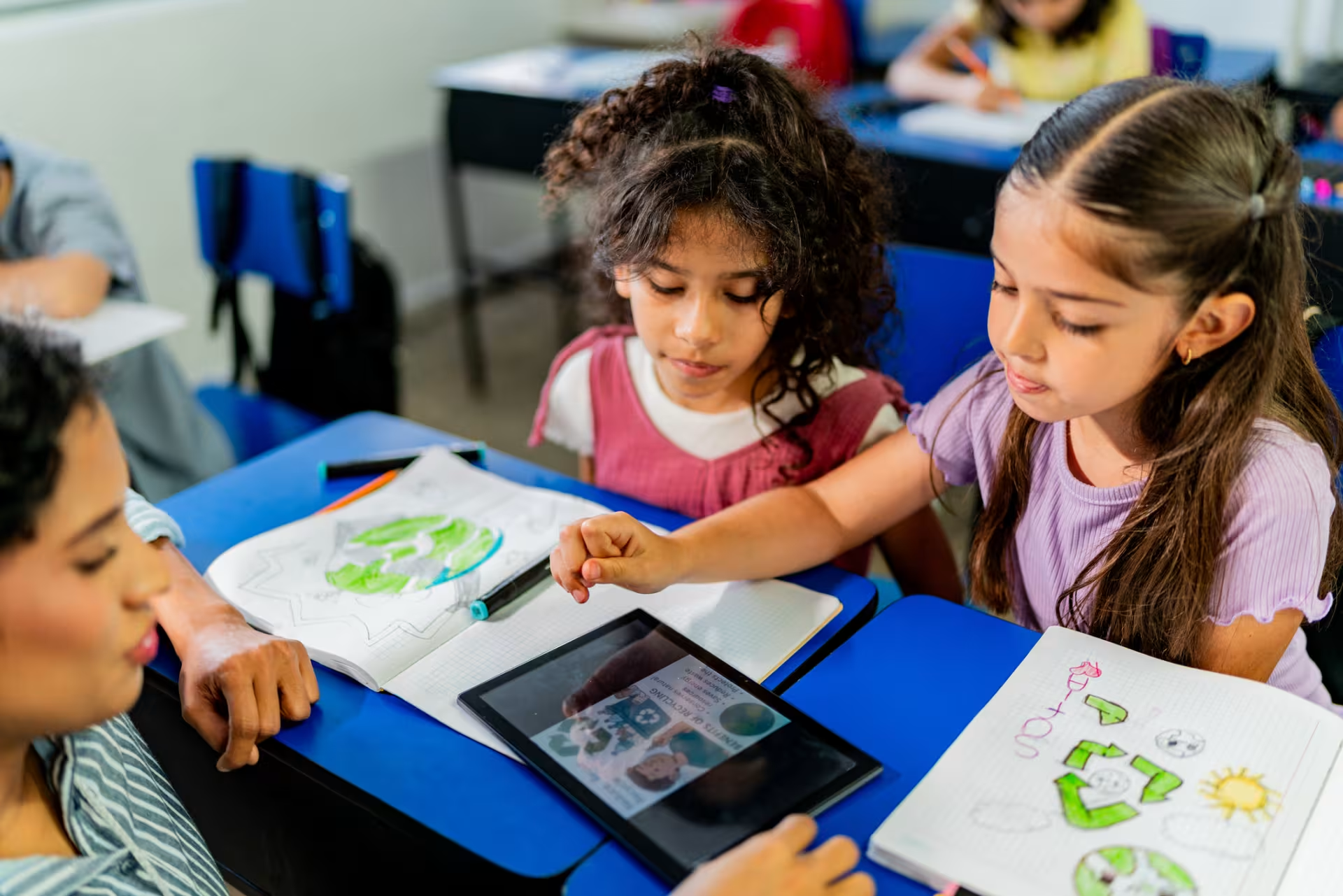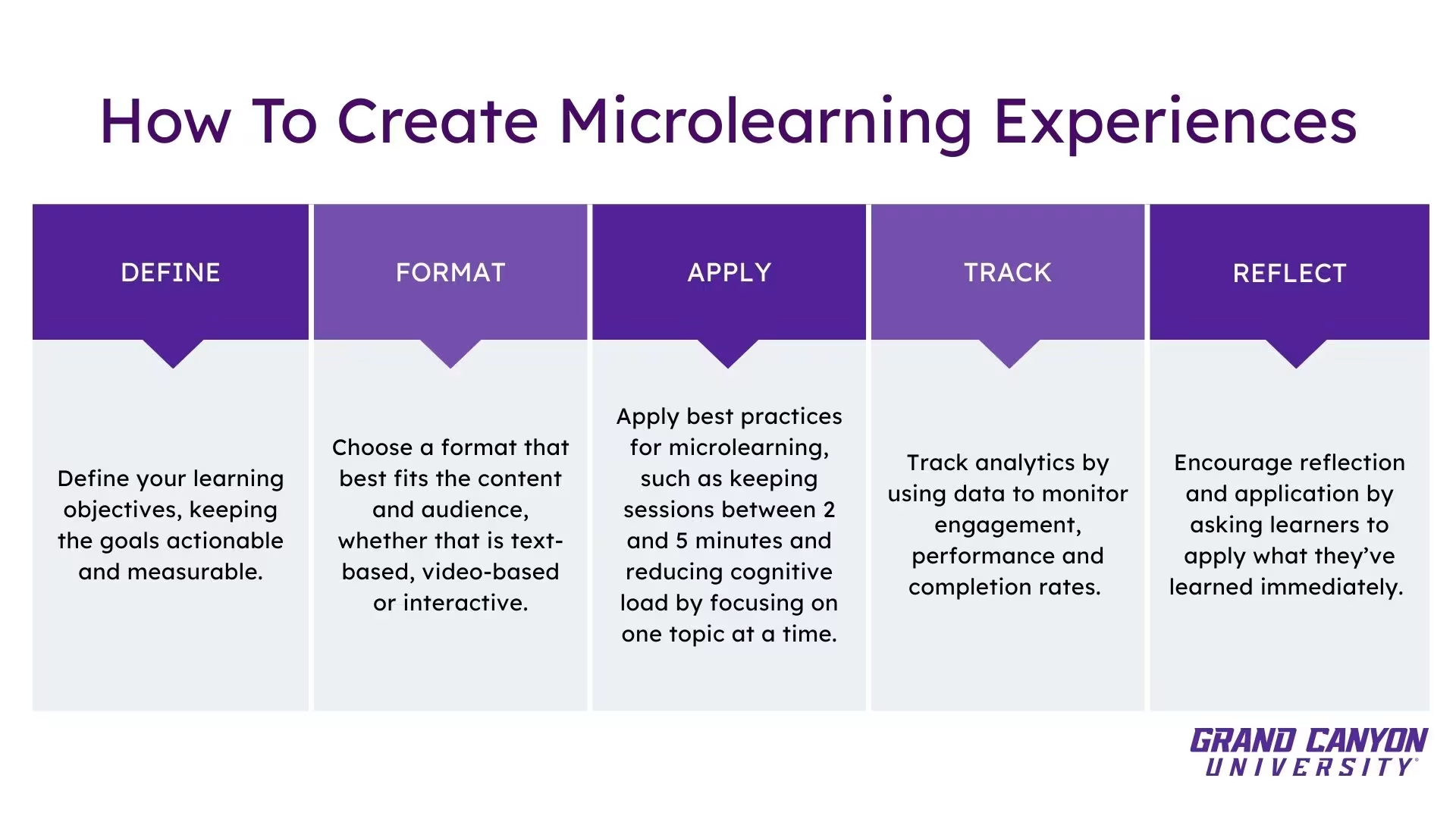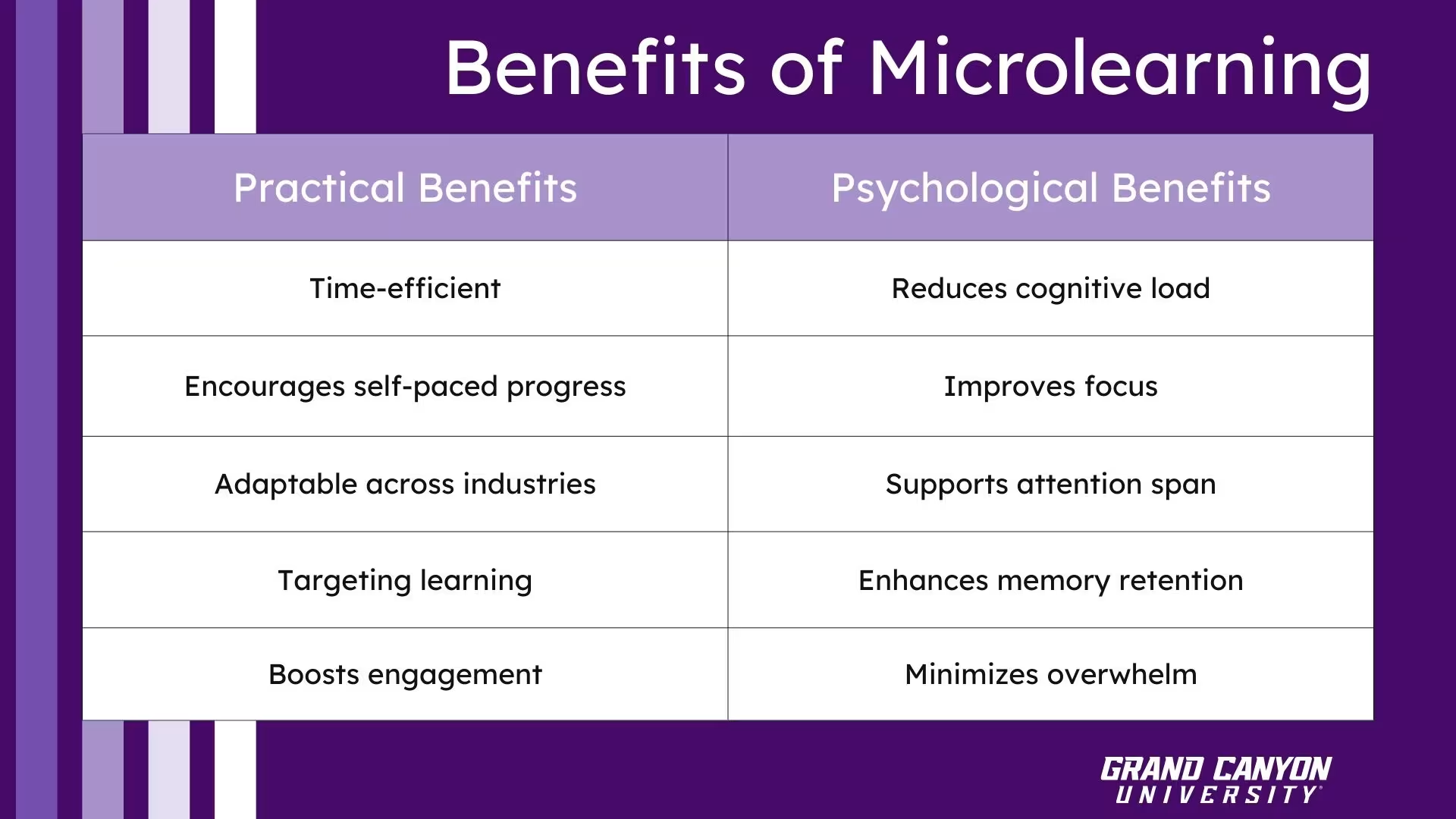Microlearning is an approach to learning where information is delivered in short, focused forms of content, intended to accomplish a specific learning objective. These learning segments are typically a few minutes long and are designed to be engaging, easily accessible and understandable.

Speak with a University Counselor today.
Approved and verified accurate by the Dean of the College of Education on Oct. 6, 2025.
The views and opinions expressed in this article are those of the author’s and do not necessarily reflect the official policy or position of Grand Canyon University. Any sources cited were accurate as of the publish date.
To answer the question, what is microlearning?, there are a few key characteristics to understand. One of the main characteristics is “bite-sized learning,” where content is constrained by time. According to the Association for Talent Development’s (ATD) research, most talent development professionals agree that for content to qualify, it should not exceed 13 minutes. The study also revealed a preference for shorter segments, with 10 minutes considered ideal and durations between two and five minutes considered the most effective.2 Teachers will need to vary their approach to microlearning based on cognitive and maturation levels.
Other key characteristics include:
Microlearning can take many forms depending on how it’s delivered and the intended goal. Some experiences are structured and tracked, while others are informal and spontaneous. Microlearning can also vary in purpose. While some lessons are designed to teach a concept, others provide quick support during a task. Understanding these types can help tailor microlearning to different learning needs and contexts.
Microlearning can be done in a formal or informal setting. Formal microlearning involves completing a curriculum or training program that accomplishes a specific learning objective. These learning experiences typically consist of modules with assessments and tracking. Formal microlearning can be used to introduce new classroom routines, support ongoing student skill development and reinforce important rules or procedures.
Informal microlearning is unstructured and spontaneous, and typically self-directed. This might look like a student watching a short educational video at home or exploring a quick tutorial on YouTube to help with homework. These types of learning experiences are not tracked and do not have formal assessments.
A recent 13-week case study published in “Education and Information Technologies” explored microlearning benefits and how it can be used to build AI literacy among pre-service teachers.5 The study integrated bite-sized content, such as short videos, interactive prompts and guided reflections, into a teacher education program focused on generative AI tools. Participants reported increased confidence and autonomy in using AI for lesson planning and instructional design. Additionally, the microlearning format helped reduce cognitive load and strengthened self-regulated learning strategies, such as goal setting and reflection. This case study demonstrates how microlearning can effectively support technical skill development and professional growth.5
Success in microlearning is measured by how effectively it helps learners achieve specific outcomes. Key indicators of success include improved knowledge retention and skill application, along with engagement metrics like completion rates and time spent on content. Feedback from learners can also offer insights into the clarity, relevance and usefulness of microlearning modules.
On-the-job performance improvements can show the value of microlearning. Academic or business outcomes, like better test scores or increased productivity, can help quantify the value of these learning experiences.
Interested in becoming an educator equipped for today’s dynamic classrooms? At Grand Canyon University, our master’s teaching degrees are designed to prepare future educators with a strong foundation in instructional strategies, including innovative tools like microlearning. You can explore how modern teaching techniques can enhance student engagement and knowledge retention. Whether you're pursuing early childhood, elementary or secondary education, GCU can help you build the skills to lead with confidence and creativity.
Earn Your Teaching Degree from GCU
Start your journey toward a teaching career with a degree from Grand Canyon University.
Creating effective microlearning experiences requires thoughtful design and an understanding of the objectives of the experience.
Here is a step-by-step guide to follow:

While there are many microlearning benefits, it may not be the best format for complex topics that require more in-depth exploration. When only short-form content is utilized, learning experiences may become oversimplified and lead to a shallower understanding of the content. Due to the short amount of time available, there could be a lack of context development that shows how topics connect to each other and form a big picture understanding of a field or concept.
Microlearning can be useful across a range of industries. Healthcare industries use microlearning through simulations to provide a realistic environment for making quick decisions about patient care in a safe environment. For example, nurses can encounter a virtual patient and decide what tests and labs to run based on the symptoms the patient is presenting. The simulation can then provide feedback on how well the nurse responded to the situation.
In a corporate context, microlearning can be used within organizations to improve workplace safety through HR modules and short videos. These can be used to teach employees about company policies as well as provide job-specific training and tutorials.
The field of education uses microlearning as an AI tool to supplement classroom learning and help students prepare for exams and state testing. Interactive stories, flashcards and gamified learning are all used to help students master concepts in mathematics, science and reading comprehension.
The applications for microlearning extend into essentially every industry, from IT providing cybersecurity awareness to the retail industry supplying staff with product updates. Any industry that requires fast and flexible learning experiences can benefit from implementing microlearning.
Microlearning is growing in popularity. According to data from EdApp, usage of microlearning platforms has increased by 700% since 2019, reflecting a significant shift in how organizations deliver training and education.1
Discover what microlearning is and how it works. Explore formats, types and teaching applications, plus tips for creating microlearning, measuring success and future trends backed by research and practical examples.
The science of microlearning is rooted in cognitive psychology and is based on the work of German psychologist Hermann Ebbinghaus. His work focused on what he called the “forgetting curve,” which describes the brain’s loss of ability to retain memory over a long period of time.3 This theory says that people tend to forget what they’ve learned unless they review the information regularly.
Microlearning can take many forms to deliver quick, focused learning experiences. Below are some of the most common microlearning examples and formats, organized by how the content is delivered.
Text-based microlearning uses written content to deliver short learning experiences. These are designed to be quick and easy to read. This includes:
Video-based learning formats are highly effective forms of microlearning that deliver visual content to break down concepts. Some of the most common video-based microlearning examples are:
Interactive tools are used in microlearning to promote critical thinking, active learning and hands-on application. Some interactive formats include:
Audio and podcast-style microlearning is a flexible format that delivers information through audio. This format can be used while commuting, walking or doing mindless tasks. Some of these formats include:
A gamified learning approach uses the elements of storytelling and challenges to provide a more engaging and motivating experience. Some gamified microlearning examples include:
New microlearning forms are emerging as new technologies become available, such as virtual reality and AI. These types of learning can use feedback to provide an individualized experience, tailored to each learner’s strengths and weaknesses.

"Microlearning can be effectively integrated into traditional classrooms by using short, focused activities such as quick videos, quizzes or bellringers, to reinforce important concepts and maintain student engagement. By providing these bite-sized learning moments, teachers can enhance retention through repetition, active recall and varied formats to meet diverse learning needs."
— Jamie Mathews, Academic Program Manager of the College of Education
There are many benefits to this framework, such as helping to reinforce learning and retain information by providing repetition. Microlearning offers both practical and psychological advantages that make it a powerful tool for modern education and training. From saving time and boosting engagement to reducing cognitive load and improving focus, these benefits support more effective, learner-centered experiences.4
